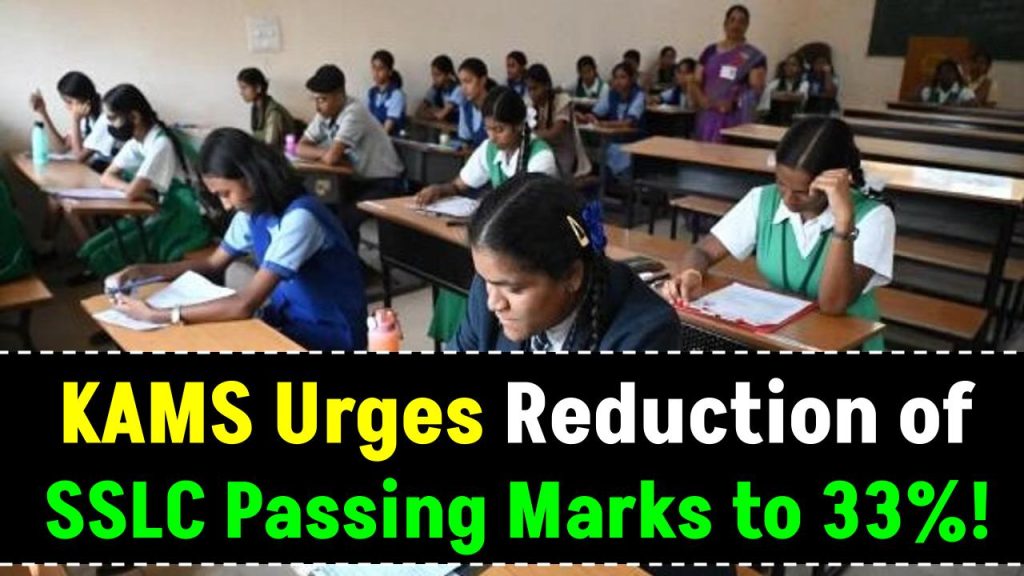
The Karnataka Association of Managements of English Medium Schools (KAMS) has recently called for lowering the SSLC (Secondary School Leaving Certificate) exam passing marks to 33%. This proposal aims to reduce the burden on students and align Karnataka’s education standards with those of other states in India.
Currently, students must score at least 35% to pass the SSLC exam, a benchmark reinstated by the Karnataka School Examination and Assessment Board (KSEAB) for the 2024-25 academic year. KAMS argues that reducing the requirement to 33% would make the exam more accessible and help improve student outcomes.
KAMS Urges Reduction of SSLC
| Topic | Details |
|---|---|
| Current SSLC Passing Marks | 35% (2024-25 academic year) |
| KAMS Proposal | Reduce passing marks to 33% |
| Previous Year’s Requirement | 25% + grace marks (2023-24) |
| Potential Benefits | Lower student stress, improved pass rates |
| Approval Authority | Karnataka School Examination and Assessment Board (KSEAB) |
| Source | KSEAB Official Website |
The proposal to lower Karnataka’s SSLC passing marks to 33% has sparked a significant debate. While it promises student relief and higher pass rates, concerns remain about academic standards and long-term impacts on education. The final decision lies with KSEAB and the Karnataka government, who will weigh the benefits and drawbacks before making any official changes.
Also Check: MOT Checklist: Simple Steps to Get Your Car Ready
KAMS Urges Reduction of SSLC: Understanding the SSLC Examination in Karnataka
The SSLC exam is one of the most crucial tests in a student’s academic journey in Karnataka. It determines eligibility for higher secondary education and plays a role in shaping future career options. The exam covers core subjects like Mathematics, Science, Social Studies, and Languages.
Why is the Passing Mark Important?
Passing marks define the minimum competency level required for students to advance. Karnataka has undergone multiple changes in its SSLC passing criteria:
- Before 2023: The required passing mark was 35%.
- 2023-24 Academic Year: Due to concerns over learning gaps caused by the pandemic, the passing mark was temporarily reduced to 25%, with grace marks provided to struggling students.
- 2024-25 Academic Year: The original 35% passing mark was reinstated.
The KAMS proposal to set the passing mark at 33% is aimed at finding a middle ground between easing student pressure and maintaining academic standards.
KAMS Urges Reduction of SSLC: Why is KAMS Advocating for a 33% Passing Mark?
KAMS believes that lowering the passing marks to 33% would:
- Reduce student stress and anxiety about exams.
- Align Karnataka’s standards with other states in India, where 33% is commonly accepted as the minimum passing mark.
- Improve overall pass percentages, leading to higher retention in higher education.
- Encourage students to stay engaged in academics without excessive pressure.
Many states, including Maharashtra, Tamil Nadu, and West Bengal, follow the 33% passing criteria, which KAMS cites as a reason for Karnataka to reconsider its own requirements.
Also Check: UK Disability Living Allowance Boost: How Much Will You Get in 2025?
KAMS Urges Reduction of SSLC: Pros and Cons of Lowering SSLC Passing Marks
Potential Benefits
Less Academic Pressure
Students often face mental health challenges due to high-stakes exams. Lowering passing marks could help reduce exam-related stress.
Higher Pass Rates
With fewer students failing, dropout rates could decrease, encouraging more students to complete their education.
Better Consistency Across India
A uniform passing percentage (33%) would align Karnataka with many other state boards, improving fairness in competitive exams.
More Opportunities for Students
Students who pass the SSLC exam with lower marks can still pursue skill-based or vocational courses, rather than facing academic setbacks.
Potential Drawbacks
Reduced Academic Standards
Lowering the passing marks might lead to concerns about compromising education quality.
Less Competitive Advantage
Students who pass with lower marks might struggle in higher education, where expectations are higher.
Opposition from Educators
Some educators argue that maintaining a higher benchmark encourages students to strive for excellence.
KAMS Urges Reduction of SSLC: How Would This Change Affect Students and Schools?
If the passing mark is officially lowered, the effects could be widespread:
- Increased Pass Rates – More students would qualify for PUC (Pre-University Courses) or vocational studies.
- Less Student Anxiety – With less pressure, students might focus more on actual learning rather than just exam preparation.
- Impacts on Higher Education – Colleges might see an increase in enrollments, leading to more competition for seats.
- Adjustments in Teaching Methods – Schools might restructure their teaching strategies to focus on understanding concepts rather than rote memorization.
A Comparison with Other States
| State | Passing Marks (%) |
|---|---|
| Karnataka (Current) | 35% |
| Karnataka (Proposed) | 33% |
| Maharashtra | 33% |
| Tamil Nadu | 33% |
| Kerala | 35% |
| West Bengal | 33% |
Also Check: Millions Set to Receive £221.20 a Week – Are You One of Them?
KAMS Urges Reduction of SSLC: What Happens Next?
The KAMS proposal is not yet approved by the Karnataka government. The final decision will be taken by KSEAB, based on discussions with educators, policymakers, and stakeholders.
If the proposal is accepted:
- The passing mark will be officially reduced to 33%.
- Students appearing for the 2025 SSLC exams may benefit from this change.
- Teachers and schools might restructure their evaluation methods accordingly.
If rejected:
- The 35% passing mark remains.
- Students will continue to prepare for exams under the current system.
KAMS Urges Reduction of SSLC (FAQs)
What are the current SSLC passing marks in Karnataka?
Currently, students must score 35% or higher in their exams to pass.
Why does KAMS want to reduce the passing marks to 33%?
KAMS argues that a 33% passing mark will:
Reduce student stress.
Improve overall pass rates.
Align Karnataka with other Indian state boards.
Will this change apply to all subjects?
Yes, if implemented, the 33% passing mark would apply to all subjects in the SSLC exams.
Has Karnataka reduced SSLC passing marks before?
Yes, during the 2023-24 academic year, the passing mark was reduced to 25%, along with additional grace marks, due to learning disruptions caused by COVID-19.
When will a final decision be made?
The decision rests with the Karnataka School Examination and Assessment Board (KSEAB), which will review the proposal and announce an official update.









